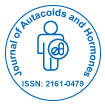Special Issue Article
Stem Cell Therapy for Endothelial Dysfunction in the Coronary Circulation
| Wei Huang1, Ronald W. Millard2 and Yigang Wang1* | ||
| 1Department of Pathology and Laboratory Medicine | ||
| 2Department of Pharmacology & Cell Biophysics, Cardiovascular Center of Excellence, College of Medicine, University of Cincinnati, Cincinnati, Ohio 45267, USA | ||
| Corresponding Author : | Yigang Wang, MD, PhD Department of Pathology and Laboratory Medicine University of Cincinnati Medical Center 231 Albert Sabin Way, Cincinnati, OH 45267-0529 Tel: 513-558-5798 Fax: 513-558-0807 E-mail: yi-gang.wang@uc.edu |
|
| Received November 24, 2011; Accepted January 09, 2012; Published January 12, 2012 | ||
| Citation: Huang W, Millard RW, Wang Y (2011) Stem Cell Therapy for Endothelial Dysfunction in the Coronary Circulation. Autacoids S3-001. doi: 10.4172/2161-0479.S3-001 | ||
| Copyright: © 2011 Huang W, et al. This is an open-access article distributed under the terms of the Creative Commons Attribution License, which permits unrestricted use, distribution, and reproduction in any medium, provided the original author and source are credited. | ||
Related article at Pubmed Pubmed  Scholar Google Scholar Google |
||
Abstract
The endothelium is increasingly recognized as serving a critical role in maintaining circulatory homeostasis. Endothelial dysfunction is evidenced as an attenuation or exaggeration of the normal dynamic vasomotor range. Circulating endothelial progenitor cells (EPCs) are responsible for the endothelial replenishment. When EPC recruitment is insufficient after endothelial injury, endothelial pathophysiological ensues. Impaired endothelial function is associated with myriad cardiovascular diseases including coronary artery disease, atherosclerosis, hypertension, chronic heart failure, peripheral artery disease, diabetes, and chronic renal failure. Therefore, correction of endothelial dysfunction presents a therapeutic opportunity that, if met, could reduce adverse cardiovascular events. EPCs play an important role in maintaining endothelial function and might affect the progression of ischemic heart disease. The mechanisms underlying the salutary effect of EPCs involve EPC-mediated paracrine effects, EPC differentiation into endothelial cells, and promoting the repair of damaged endothelium. The implementation of EPCs is emerging as a new promising cell-based therapy for restoration of angiogenic activity in cardiovascular disease, which might be particularly beneficial. The goal of this article is to review and critically evaluate the relevant literature describing putative role of EPCs in the treatment of ischemic heart disease, especially that of the coronary arterial system, that is rooted in endothelial dysfunction.

 Spanish
Spanish  Chinese
Chinese  Russian
Russian  German
German  French
French  Japanese
Japanese  Portuguese
Portuguese  Hindi
Hindi